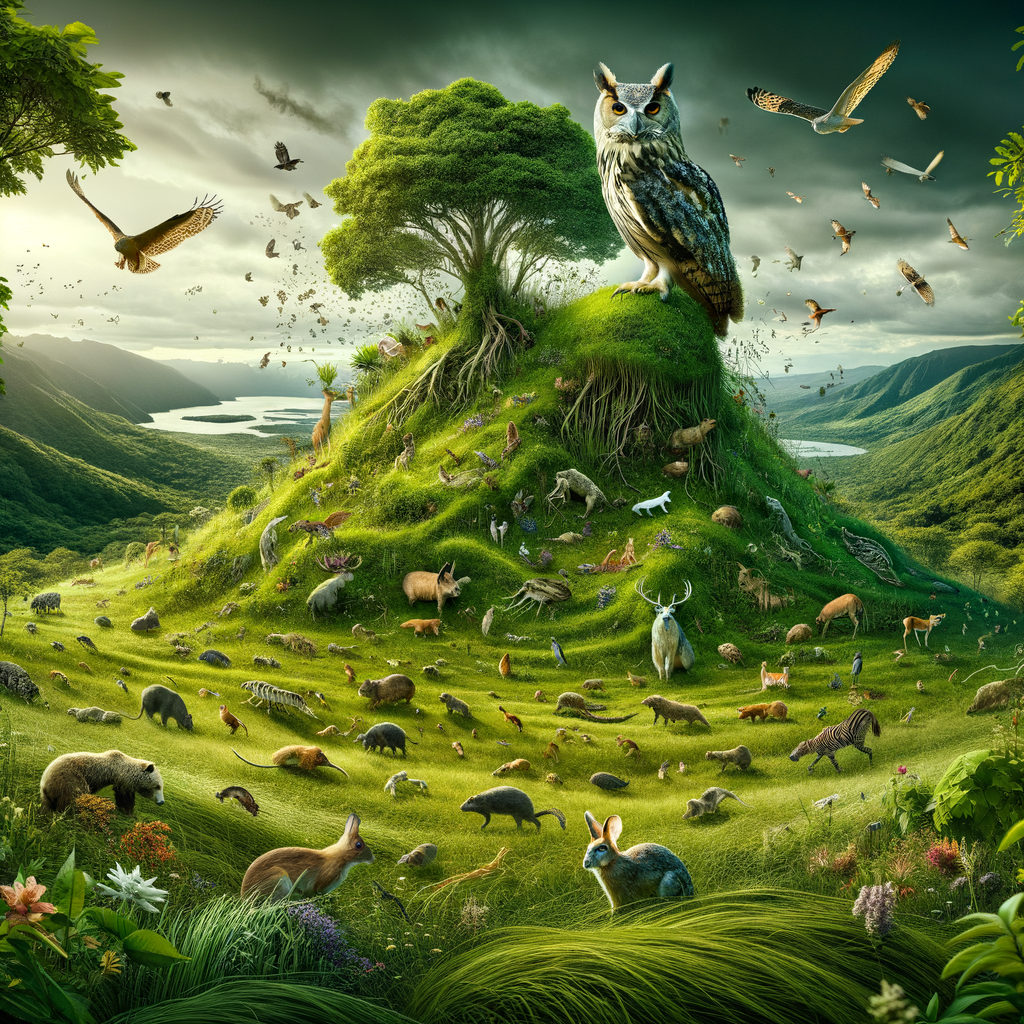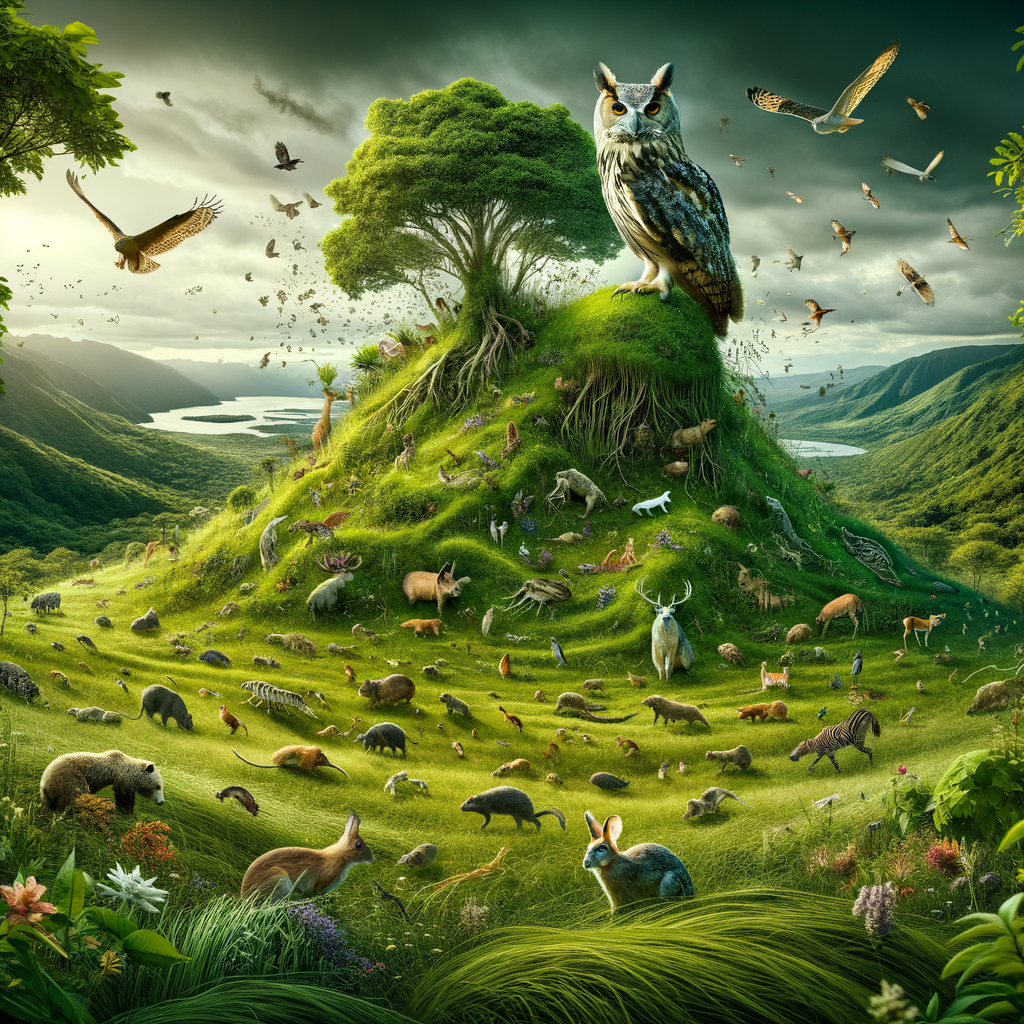
Introduction to Owls in Grassland Ecosystems
- Overview of the role of owls in grassland ecosystems:
Owls are fascinating birds that play a crucial role in grassland ecosystems. These nocturnal predators help control the population of small mammals, insects, and other prey. By hunting at night, owls ensure that the balance of the ecosystem is maintained. They are often seen as indicators of a healthy environment. - Importance of owls in maintaining grassland ecosystem balance:
Owls are vital for keeping the grassland ecosystem in balance. They help reduce the number of rodents and insects, which can otherwise become pests. This control prevents overgrazing and damage to crops. Additionally, their presence supports biodiversity by allowing other species to thrive. Without owls, the ecosystem could become unbalanced, leading to various environmental issues.
Grassland Owl Species
-
Introduction to Different Species of Owls Found in Grasslands
These owls have adapted to the open, grassy landscapes. They are important for keeping the ecosystem balanced. Let’s explore some of these fascinating birds.
-
Characteristics of Each Species
Owl Species Unique Characteristics Short-eared Owl These owls have short ear tufts and are known for their excellent hunting skills during the day. They have a wingspan of about 3.3 feet. Burrowing Owl Burrowing Owls live in burrows in the ground. They have long legs and are active during the day. They are small, about 9 inches tall. Barn Owl Barn Owls have a heart-shaped face and are known for their silent flight. They are great hunters, especially at night. Their wingspan can reach up to 3.5 feet. Each of these owls has special traits that help them survive in the grasslands. Their unique features make them well-suited to their environment.
Owl Habitat in Grasslands
Physical Characteristics of Owl Habitats
- Geographical distribution of owl habitats in grasslands:
These areas include the prairies of North America, the savannas of Africa, and the steppes of Eurasia. Each region has unique features that make it suitable for different owl species. - Physical features of owl habitats:
Grassland habitats for owls often include open fields, scattered trees, and shrubs. These features provide owls with places to perch and hunt. Some owls also use burrows or nests in tall grasses for shelter and breeding.
Impact of Habitat on Owl Behavior
-
- How habitat influences owl hunting behavior
Their habitat plays a big role in how they hunt. In grasslands, owls use tall grasses to hide. This helps them sneak up on their prey. They often hunt small animals like mice and insects. The open space of grasslands makes it easier for owls to spot their prey from a distance.
For example, the Barn Owl is known for its silent flight. This helps it catch prey without being heard. Grasslands provide the perfect setting for this kind of hunting. The flat terrain allows the Barn Owl to glide smoothly and catch its prey with ease.
-
- Impact of habitat on owl breeding and nesting
Grasslands offer many nesting sites. Owls often nest in trees, tall grasses, or even on the ground. The availability of food in grasslands supports the growth of owl families.
For instance, the Short-eared Owl prefers to nest on the ground. It uses tall grasses to hide its nest from predators. This habitat choice helps protect its eggs and young owlets. The abundance of food in grasslands ensures that the owlets grow strong and healthy.
Predatory Birds in Grasslands
Owls as Predatory Birds
- Role of owls as predators in grasslands: Owls are essential predators in grasslands. They help keep the ecosystem balanced by controlling the population of small animals. Owls hunt at night, using their excellent vision and hearing to find prey.
- Impact of owls on grassland rodents: Owls have a significant impact on grassland rodents. By hunting mice, voles, and other small mammals, they help prevent these rodents from overpopulating. This control is crucial because too many rodents can damage crops and spread disease.
| Owl Species | Primary Prey | Hunting Time |
|---|---|---|
| Barn Owl | Rodents | Night |
| Short-eared Owl | Small mammals | Day and Night |
Owls play a vital role in maintaining the health of grassland ecosystems. Their predatory habits ensure that the populations of small animals remain in check, which benefits the entire ecosystem.
Comparison with Other Predatory Birds
- Comparison of owls with other predatory birds in grasslands:
In grasslands, there are many predatory birds like hawks, eagles, and falcons. Owls are different from these birds in several ways. For example, hawks and eagles hunt during the day, while most owls hunt at night. This means owls have less competition for food.
Another difference is in their hunting techniques. Hawks and eagles often soar high and dive to catch prey. Owls, on the other hand, fly silently and swoop down on their prey. This silent flight helps them catch animals by surprise.
Here is a table comparing some key features:
Feature Owls Hawks/Eagles Hunting Time Night Day Hunting Technique Silent flight High soaring and diving Vision Excellent night vision Excellent day vision - Predatory characteristics of owls:
Owls have some unique features that make them excellent hunters. One of these is their ability to rotate their heads up to 270 degrees. This helps them see in all directions without moving their bodies.
Another unique characteristic is their sharp talons and beaks. These help them catch and eat their prey quickly. Owls also have special feathers that allow them to fly silently. This silent flight is a big advantage when hunting at night.
According to Wikipedia, owls have asymmetrical ears. This means their ears are not at the same height on their heads. This helps them pinpoint the exact location of sounds, making it easier to find prey in the dark.
Owl Diet in Grasslands
-
Common prey of owls in grasslands
They often hunt small mammals like mice, voles, and rabbits. These animals are abundant in grasslands and provide a steady food source for owls. Some owls also eat insects, birds, and even small reptiles.
| Common Prey | Examples |
|---|---|
| Small Mammals | Mice, Voles, Rabbits |
| Insects | Beetles, Grasshoppers |
| Birds | Sparrows, Finches |
| Reptiles | Small Snakes, Lizards |
-
Impact of owl diet on grassland biodiversity
Owls play a crucial role in maintaining the balance of grassland ecosystems. By preying on small mammals, they help control the population of these animals. This, in turn, prevents overgrazing and allows plants to thrive. Healthy plant life supports a wide range of other species, contributing to overall biodiversity.
For example, a study showed that areas with a high owl population had fewer rodents, which led to more plant growth. This attracted more insects and birds, creating a richer ecosystem.
In summary, owls are essential for keeping grasslands healthy. Their diet helps control animal populations and supports plant life, which benefits the entire ecosystem.
Owl Conservation in Grasslands
Threats to Owl Populations
- Major threats to owl populations in grasslandsOne big threat is habitat loss. When people build houses or farms, they take away the places where owls live. Another threat is pesticides. Farmers use these chemicals to kill pests, but they can also harm owls. Climate change is another problem. It can change the weather and make it hard for owls to find food.
- Impact of these threats on grassland ecosystemsOwls help control the population of small animals like mice and insects. Without owls, these animals can become too many and harm the plants. This can make the grasslands less healthy. Protecting owls helps keep the grasslands balanced and thriving.
Conservation Efforts
-
Current conservation efforts for owls in grasslands
They focus on preserving habitats, reducing pesticide use, and educating the public. For example, the Audubon Society has programs to protect owl nesting sites. They also work with farmers to create owl-friendly environments.
Another effort is the use of protected areas. These are special zones where owls can live safely. Governments and NGOs set up these areas to ensure owls have a place to hunt and nest without danger.
Additionally, research projects help us learn more about owls. Scientists study their behavior, diet, and migration patterns. This information helps create better conservation plans.
-
Success stories and case studies of owl conservation
One great example is the recovery of the Burrowing Owl in California. Conservationists worked with local communities to protect nesting sites. They also built artificial burrows to help the owls. As a result, the Burrowing Owl population has increased.
Another success story is from the grasslands of Canada. The World Wildlife Fund (WWF) partnered with farmers to reduce pesticide use. This helped increase the number of prey animals for owls. The project was so successful that it became a model for other regions.
Here is a table summarizing these efforts:
Region Effort Outcome California Protecting nesting sites, building artificial burrows Increased Burrowing Owl population Canada Reducing pesticide use More prey animals for owls
Ecological Role of Owls
-
How Owls Contribute to Grassland Biodiversity
They help keep the ecosystem balanced by preying on various small animals. This helps to control the population of these animals, which in turn supports plant life. When there are fewer small animals eating plants, the plants can grow better. This creates a healthier environment for all living things in the grassland.
For example, the presence of owls has been linked to healthier plant life in many grassland areas. By keeping the number of small animals in check, owls help to maintain a diverse range of plant species. This diversity is important because it supports other animals, insects, and birds that rely on these plants for food and shelter.
-
Role of Owls in Controlling Rodent Populations
Owls are natural predators of rodents like mice and rats. These rodents can cause a lot of damage to crops and spread diseases. By hunting these rodents, owls help to keep their numbers down. This is very important for farmers and people living in grassland areas.
Studies have shown that areas with healthy owl populations have fewer problems with rodents. For instance, a single barn owl can eat up to 1,000 rodents in a year. This makes owls very effective in controlling rodent populations naturally, without the need for harmful chemicals or traps.
Conclusion: The Vital Role of Owls in Grasslands
Owls play a crucial role in grassland ecosystems. They help maintain a balance by controlling the population of small mammals and insects. This balance is essential for the health of the grasslands.
- Summary of the importance of owls in grassland ecosystems: Owls are top predators in grasslands. They keep the population of rodents and insects in check. This helps prevent overgrazing and crop damage.
- Key takeaways about the role of owls in grasslands:
- Owls help control pest populations.
- They contribute to the biodiversity of grasslands.
- Conserving owls is vital for maintaining healthy ecosystems.
Owls are vital to the health of grassland ecosystems. They help control pests, support biodiversity, and maintain ecological balance. Protecting these amazing birds ensures the continued health and sustainability of grasslands.






